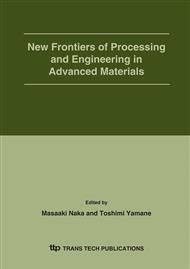p.263
p.269
p.275
p.281
p.287
p.291
p.297
p.303
p.309
Microstructure and High Temperature Deformation of Grain Refined Al Alloy Foil Fabricated by RF Magnetron Sputtering
Abstract:
The present paper describes microstructure and mechanical properties of a grain refined Al alloy foils fabricated by RF magnetron sputtering method utilizing a commercial 7475Al alloy as a sputtering target. Microstructure of deposited foils was evaluated by means of SEM, TEM, SEM-EPMA and X-ray diffraction methods. Mechanical properties were analyzed by the Vickers hardness test and by tensile test at various temperatures. Columnar grains having a mixed grain size ranging from some hundreds microns to 1 micron on the planar section was obtained, and the foils were super-saturated solid solution with FCC structure. The foils contained less Mg content than the sputtering target. Superplastic deformation was observed for the foils at elevated temperature and the maximum elongation of 370% was obtained when deformed at 863K with the initial strain rate of 1.4 x 10-1s-1.
Info:
Periodical:
Pages:
287-290
Citation:
Online since:
December 2005
Price:
Сopyright:
© 2005 Trans Tech Publications Ltd. All Rights Reserved
Share:
Citation:


